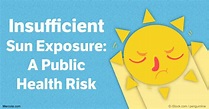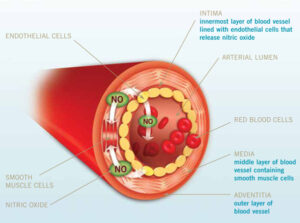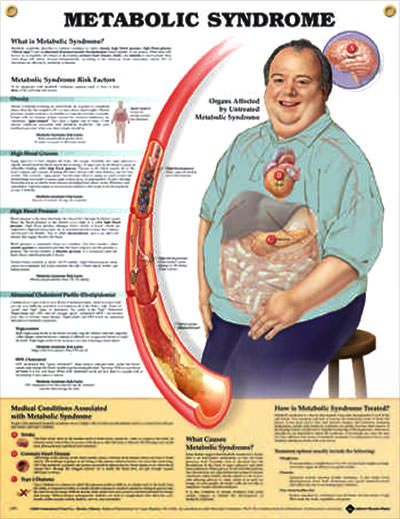Insufficient sunlight destroys health. By Marc Sorenson, EdD
Insufficient sunlight is wreaking havoc on health and ruining the enjoyment sunlight provides. Yet, we choose to live in air-conditioned homes, play many of our sports in covered buildings and drive covered cars. In addition, advertisements persuade us that we must wear sunscreen anytime we venture outdoors. Some also suggest that we wear it at night. Thus, they think we can prevent “sun damage” that continues after daytime outdoor sun exposure. It is obvious that the greater part of our population suffers sunlight deprivation. Or, as a recent scientific review called it, “insufficient sun exposure.”
The paper, Insufficient Sun Exposure Has Become a Real Public Health Problem, exposes the damage done due to sun deprivation.
First of all, the authors begin by stating that deaths due to insufficient sunlight are staggering. They amount to 340,000 yearly deaths in the U.S. and 480,000 in Europe. They then delineate the source of those deaths, first declaring a list of major maladies that spread illness and misery. The list includes breast and colorectal cancer, hypertension, CVD, metabolic syndrome, MS, Alzheimer’s, autism, asthma, type 1 diabetes and myopia. In addition, excessive mortality (death) was also on the list due to of insufficient sunlight. Yet, although the list of these sun-sensitive diseases is impressive, I must say I was disappointed. They did not mention another 15 cancers and other diseases associated closely to insufficient sunlight. For those cancers, and additional diseases, read the book, Embrace the Sun, which I wrote with Dr. William Grant.
For decades, scientists designated vitamin D as the only photoproduct of sunlight that produced benefits.
One of the paper’s salient points regarding insufficient sunlight and is transcendentally important. I have been emphasizing the point for years, yet much of the world ignores it. The point is that vitamin D is a vital and important photoproduct of sun exposure. Yet, other photoproducts of sunlight are equally vital. This statement by the authors tends to clarify the truth about Vitamin D and its place with human health. “Vitamin D has long been considered the principal mediator of beneficial effects of sun exposure. However, oral vitamin D supplementation has not been convincingly shown to prevent the above conditions; thus, serum 25(OH)D as an indicator of vitamin D status may be a proxy for and not a mediator of beneficial effects of sun exposure.”
The authors also mention that nitric oxide, and direct effects of ultraviolet radiation, may work independently of vitamin D. For example, nitric oxide is a colorless gas, formed by sunlight exposure to endothelial cells in the skin. It acts as a potent vasodilator and lowers blood pressure. In addition, it is also a potent antioxidant. Of course, insufficient sunlight leads to a lack of nitric oxide, vitamin D and other vital photoproducts.
Here are the explanations used in the review regarding different diseases associated with insufficient sun exposure. Nevertheless, these diseases do not necessarily improve due to vitamin D supplements. Note: the term nmol/L means nanomoles/ per liter, and U.S. measurements are in ng/ml (nanograms per milliliter). To convert nmol/L to ng/ml, multiply by 2.5.
-
All-cause mortality (death) Effects of insufficient sunlight
The review also states that insufficient sunlight is a risk factor for death similar to that of smoking. In addition, people with serum vitamin D levels less than 22 nmol/L, have twice the risk of all-cause death. That is, compared to those whose levels were greater than 125 nmol/ (about 50 ng/ml). Remember, vitamin D levels in these cases are really proxies for sun exposure.
-
Breast cancer. Effects of insufficient sunlight
-
The review quotes research showing a 400% increased breast cancer risk is associated with vitamin D levels less than 50 nmol/L when compared to levels greater than 150 nmol/L. Think sunlight. The vitamin D levels are surrogate measurements for sun exposure.
-
Colorectal cancer. Effects of insufficient sunlight
The authors quote a meta-analysis showing a 104% higher risk associated with vitamin D levels less than 30 nmol/L compared to those with levels higher than 82 nmol/L. Interestingly, another study, using animals, showed that neither vitamin D nor UVR (sunlight) was associated with the number of cancer tumors. Nevertheless, ultraviolet radiation (UVR), but not vitamin D, appeared to reduce progression to malignancy. Insufficient sun exposure then, could lead to colorectal cancer.
-
Cardiovascular disease (CVD), our number-one killer. Effects of insufficient sunlight
In their review, the authors note CVD has been the leading cause of death globally for the last three decades. In addition, hypertension, or high blood pressure is the number-one risk factor for (CVD). The review states that a growing body of evidence shows an inverse relationship between sunlight exposure, blood pressure and CVD. The authors indicate that a mediator other than vitamin D probably contributes to CVD mortality. Thus, nitric oxide, a sun-exposure product and potent vasodilator, may be the chemical that lowers blood pressure and reduces CVD. The researchers further state that those with habitual low sun exposure double the risk of cardiovascular death compared with those who receive the greatest sun exposure. Obviously, insufficient sunlight can be a deadly contributor to CVD due to an inability to produce sufficient nitric oxide.
5. Metabolic syndrome (MetS). Effects of insufficient sunlight
MetS is a cluster of maladies including glucose intolerance, insulin resistance and high fasting insulin levels. MetS also may include nonalcoholic fatty liver disease, obesity, and cholesterol. All of these factors contribute to heart disease and diabetes. The review noted that UVR suppressed obesity and type 2 diabetes, yet, vitamin D supplementation did not produce the same benefits. The review also suggested that sunlight exposure is an effective suppressor of obesity and MetS through vitamin D-independent mechanisms.
Other diseases, due to insufficient sunlight, to follow later:
Other diseases in the review also indicated an association to insufficient sunlight. I will expatiate on those diseases in a future blog. Until then, be sure to obtain your share of non-burning, regular sun exposure to your skin. In addition, as autumn arrives, you will need a different source of vitamin D production. This is due to the sun’s UVB light being unavailable in autumn and winter in mid to high latitude areas. Therefore, the suggestion is to use a sunbed, which produces vast quantities of vitamin D. Sunbeds also produce vast quantities of UVA light that stimulate nitric oxide in the skin. Therefore, sunbeds are the perfect answer for those times when there is little sunlight availability.
For more information on the healthful effects of sun exposure, visit Sunlight Institute and read my book, Embrace the Sun.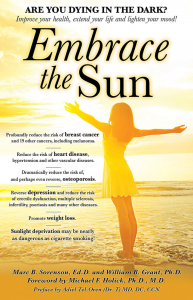
By Marc Sorenson, EdD.
Metabolic syndrome, first of all, is a combination of disorders existing concurrently in a human or other animal. So what are these disorders? One can usually discern them with a glance at the people walking the American streets. They are abdominal obesity, high blood pressure, high triglyceride levels and low HDL cholesterol levels. And what are the dangers of metabolic syndrome? Most noteworthy are heart disease, stroke and diabetes, as well as obesity itself. Thus, metabolic syndrome is indicative of deteriorating health.
New, fascinating research has shown a link between metabolic syndrome and Lack of sunlight.
According to Medical News Today, animals can detect light in areas other than the eyes. Especially relevant are proteins called opsins, which detect light in the eye’s retinal cells. However, in addition, it is now known that opsins in the skins of mice can react to sunlight and help to reset circadian rhythms. Nevertheless, until now, it was not suspected that opsins could help to reduce metabolic syndrome.
Also of transcendent importance is the fact that opsins exist below the skin surface. They are also found on fat cells. And when sunlight contacts the skin, the light can penetrate deeply enough to stimulate opsin activities in those cells. Thus, opsins are “turned on” and activate the process of lipolysis, whereby fatty acids are released from the fat cell into the blood.
Another process then occurs: the fatty acids are “burned” by the body to produce heat. And the upshot of this progression? It reduces obesity. And, metabolic syndrome lessens. Hence, the person achieves better health! I have almost come to believe that there is no aspect of human health that sun exposure cannot help, when used properly. In this study, blue light appeared to be the most important spectrum of sunlight.
Other research indicative of a positive effect on obesity.
Another scientific paper “sheds more light” on the subject of obesity. This research was conducted on mice with shaved backs that were placed on a high-fat diet and then exposed to non-burning ultraviolet radiation (UVR) during a three-month experiment. The mice, without the benefit of UVR, would have been expected to gain weight rapidly on that diet, but when they were exposed to UVR, the weight gain was impressively reduced.
The UVR treatment achieved a 30-40% reduction in weight gain, compared to the expected weight gain with the high-fat diet. And, none of these benefits could be accomplished by vitamin D supplementation. However, stimulation of nitric oxide increase in the skin was able to produce some of the benefits of UVR. This also indicate that either sun exposure or sunbeds could help the health (we know that both do exactly that). However, it was not determined whether opsins had any part to play.
Finally, morning sunlight reduces obesity. 
A recent study demonstrates that timing and intensity of light correlate with body mass index (BMI). BMI is a numerical computation comparing height and weight, and is a commonly used method to assess obesity or the lack thereof. A high BMI usually means a person is obese or at least approaching obesity.
After adjusting for confounders such as diet, exercise and timing of sleep, it was determined that very early exposure to morning light correlated remarkably to lower BMI. Even when light intensity was equal at different times of the day, those who received the earliest bright light had lower BMI. In fact, for each hour later in the day when light exposure occurred, BMI increased by 1.3 units. This is exceptionally important, since a person who has a BMI of 25 (upper ideal range) could approach 30 (obesity) by rising later.
Remember that regular, non-burning sun exposure is vital for human health. Happy sunning!
For more information on sunlight and health, visit http://sunlightinstitute.org/ and read the book, Embrace the Sun. The book is available at Amazon.
What is metabolic syndrome?
Metabolic syndrome is a group of physical conditions that are predictors of disease. And, it can also be an indicator that disease is already present. Hence, when someone suffers from metabolic syndrome, they will have many dangerous disorders. High blood pressure, obesity, high cholesterol, high triglycerides, Low HDL, glucose intolerance and insulin resistance. Furthermore, these disorders are linked to increased risk of cardiovascular disease and type 2 diabetes. And, they are often indicative of upcoming health disasters.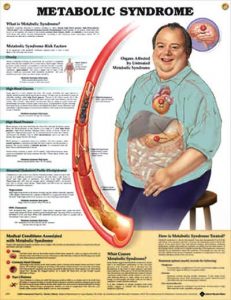
How metabolic syndrome is influenced by sunlight.
First of all, how does this tie into the benefits of sunlight? A recent study showed that a program designed to raise vitamin D levels reduced existing metabolic syndrome remarkably.[1] Fifty-nine people with metabolic syndrome participated in the study. It is most noteworthy that these subjects were told to expose themselves regularly to sunlight and eat foods high in vitamin D. Metabolic syndrome, as a result, decreased by about half after one year on this regimen.
Does other research associate metabolic syndrome with sun exposure?
One major aspect of metabolic syndrome is obesity. Hence, research demonstrating a reduction of obesity also indicates a reduction of metabolic syndrome. So, let’s mention another scientific paper that “sheds more light” on the subject of obesity.[2] This research was conducted on mice with shaved backs that were placed on a high-fat diet and then exposed to non-burning ultraviolet radiation (UVR). UVR is one of the types of light that is produced by sunlight. Especially relevant is that the mice should have gained weight rapidly. But the weight gain was impressively reduced when they were exposed to UVR. The treatment achieved a 30-40% reduction in weight gain, compared to the expected weight gain with the high-fat diet. Therefore, the “sun treatment” reduced the risk of obesity. And, it also reduced metabolic syndrome.
Other metabolic syndrome changes shown in this research
Benefits of these treatments also included: significant reductions in glucose intolerance, insulin resistance and fasting insulin levels (all markers and predictors of diabetes and metabolic syndrome). In addition, nonalcoholic fatty liver disease and high cholesterol were also reduced.
Furthermore, a very interesting finding emerged: Supplementation with vitamin D actually reduced the aforementioned beneficial effects. Dr. Shelley Gorman, The research leader, made the following interesting observations:
- “These findings were independent of circulating vitamin D and could not be mimicked by vitamin D supplementation.”
- “It looked like the presence of vitamin D in mice on the high fat diet prevented the [beneficial] effect of UV radiation on weight gain.”
- Furthermore, Dr. Gorman mentioned that the mechanism of weight loss may be dependent on nitric oxide (NO). NO originates from diet and is mobilized by UV radiation to become bioactive. This conclusion was due to another part of the experiment. Skin induction of nitric oxide (NO)—also a product of skin exposure to the sun—reproduced many of the positive effects of UVR. This was something vitamin D supplements could not do.
In conclusion to this research, the investigators stated their findings. “These studies suggest UVR [sun exposure] may be an effective means of suppressing the development of obesity and MetS, through mechanisms independent of vitamin D but dependent on other UVR-induced mediators such as NO.”
It seems like there is no end to the miracles of regular, non-burning sun exposure. Consequently, do not disregard the sun and its health-giving effects. Just don’t burn. For more information, read my book, Embrace the Sun, available at Amazon. 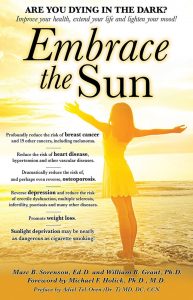
[1] Nasser M. Al-Daghria, Khalid M. Alkharfya, Yousef Al-Salehb, Omar S. Al-Attas et al. Modest reversal of metabolic syndrome manifestations with vitamin D status correction: a 12-month prospective study.
[2] Geldenhuys S, Hart PH, Endersby R, Jacoby P, Feelisch M, Weller RB, Matthews V, Gorman S. Ultraviolet radiation suppresses obesity and symptoms of metabolic syndrome independently of vitamin D in mice fed a high-fat diet. Diabetes. 2014 Nov;63(11):3759-69
By Marc Sorenson, EdD, for safe sun exposure…
There is an alarming increase in obesity In the United States. Obesity is determined by a measurement called Body-mass index (BMI) which compares a person’s height with his weight and uses a mathematical formula for its calculation. To quickly calculate your BMI, go to this website: https://www.nhlbi.nih.gov/health/educational/lose_wt/BMI/bmicalc.htm. A BMI less than 24.9 is considered normal; 25-29.9 overweight; 30 and over obese, and 40+ extremely (or morbidly) obese. Since the early 1960s the prevalence of obesity among adults more than doubled, increasing from 13.4% of adults in 1960 to 37.5% in 2010. We obviously have a severe problem, with two in three adults now either overweight or obese.[1]
There is little doubt as to the cause of obesity. We lack exercise, eat high-calorie junk foods and have moved away from sun exposure, this due to indoor living and a misguided fear of skin cancer. Most people would not put sun exposure in the list of causes, but research shows that it may play an important part in this increasing plague.
Marching in lockstep with the increase in obesity is an increase in type-2 diabetes and metabolic syndrome, which is defined as group of disorders (high blood pressure, abdominal obesity, high cholesterol, high triglyceride levels, low HDL levels and insulin resistance) that are linked to increased risk of cardiovascular disease and type 2 diabetes. This was the conclusion of a recent review on the influence of sun exposure on these conditions: “Overall, emerging findings suggest a protective role for UVR and sun exposure in reducing the development of obesity and cardiometabolic dysfunction.”[2]
Other research has led to similar conclusions. A recent study from Northwestern Medicine demonstrates that timing and intensity of light correlate with body mass index (BMI).[3] This research showed that exposure to bright morning light was directly related to BMI. After adjusting for confounders such as diet, exercise and sleep timing, it was determined that very early sun exposure correlated remarkably to lower BMI; even when light intensity was equal at different times of the day, those who received the earliest bright light had lower BMI. In fact, for each hour later in the day that the light exposure occurred, BMI increased by 1.28 units. This fact is exceptionally important, since a person who has a BMI of 25 (upper ideal range) could approach 30, or obesity, simply by the habit of sun exposure later in the day, i.e. 10:00 AM rather than 6:00 AM. The authors of this research suggested that the mechanisms involved in weight control by early light exposure could be the following: (1) resetting the circadian rhythm (internal clock), (2) the greater quantity of blue light in morning sun and (3) effects on melatonin production. Whatever the mechanisms, we now know that early-morning sun is important to weight control. It may also be important to other health issues.
Another scientific paper was recently published that “sheds more light” on the subject of obesity.[4] This research was conducted on mice that were placed on a high-fat diet and then exposed to non-burning ultraviolet radiation (UVR) during a three-month experiment. The mice, without the benefit of UVR, would have been expected to gain weight rapidly, but when they were exposed to UVR, the weight gain was impressively reduced; the UVR treatment achieved 30-40% less weight gain, compared to the expected weight gain with the high-fat diet. The quantity of UVR exposure to the mice was proportionally equal to the quantity of sun exposure that a human would be exposed to by standing in the sun for ten minutes at noon.
So add sun exposure to the list of aids for obesity. Just be safe and do not burn. Let’s learn to live off the fat of the land but not be part of it!
[1] https://www.niddk.nih.gov/health-information/health-statistics/Pages/overweight-obesity-statistics.aspx
[2] Gorman S, Lucas RM, Allen-Hall A1, Fleury N, Feelisch M. Ultraviolet radiation, vitamin D and the development of obesity, metabolic syndrome and type-2 diabetes. Photochem Photobiol Sci. 2016 Dec 23. doi: 10.1039/c6pp00274a. [Epub ahead of print]
[3] Reid KJ, Santostasi G, Baron KG, Wilson J, Kang J, Zee PC. Timing and intensity of light correlate with body weight in adults. PLoS One 2014;2;9(4)
[4] Geldenhuys S, Hart PH, Endersby R, Jacoby P, Feelisch M, Weller RB, Matthews V, Gorman S. Ultraviolet radiation suppresses obesity and symptoms of metabolic syndrome independently of vitamin D in mice fed a high-fat diet. Diabetes. 2014 Nov;63(11):3759-69
By Marc Sorenson, EdD. Sunlight Institute…
Sun exposure reduces the risk of obesity, and that relationship has been credited to vitamin D. However, one study, conducted on mice, shows that vitamin D may have nothing to do with reducing or preventing obesity.[1] The animals were placed on a high-fat diet to cause obesity. Then they were subjected to long-term exposure to ultraviolet radiation (UVR), (which is the same sunlight spectrum that leads to the production of vitamin D and other photoproducts). The UVR significantly suppressed weight gain and other measures of the metabolic syndrome (MetS), including glucose intolerance, insulin resistance, fasting insulin levels, fatty liver disease and serum cholesterol levels.
Interestingly, when the animals were supplemented with vitamin D, no such benefits occurred, meaning that UVR created the positive protections independently. However when nitric oxide was applied to the skin of the animals, the positive effects on weight loss and metabolic syndrome were again observed. Nitric oxide, of course, is another photoproduct of sun exposure, which has many positive health effects.
Other research showed that early-morning sun exposure was correlated to lower body-mass index (BMI) which is a measure of body fatness.[2] The authors of that research suggested that the mechanisms involved in weight control by early light exposure could be the following: (1) resetting the circadian rhythm (internal clock), (2) the greater quantity of blue light in morning sun and (3) effects on melatonin production. Whatever the mechanisms, we now know that early-morning sun is important to weight control. It may also be important to other health issues. But before we begin to think that sun exposure is the cure-all for obesity, realize that poor nutritional habits and lack of exercise are much more important. Nevertheless, sun exposure can furnish one more arrow in the quiver of protection from obesity.
Get your sun exposure and stay slim! Be careful not to burn.
[1] Geldenhuys S, Hart PH, Endersby R, Jacoby P, Feelisch M, Weller RB, Matthews V, Gorman S. Ultraviolet radiation suppresses obesity and symptoms of metabolic syndrome independently of vitamin D in mice fed a high-fat diet. Diabetes. 2014 Nov;63(11):3759-69.
[2] Reid KJ, Santostasi G, Baron KG, Wilson J, Kang J, Zee PC. Timing and intensity of light correlate with body weight in adults. PLoS One 2014;2;9(4)
By Marc Sorenson, EdD Sunlight Institute…
Dr. Richard Weller, a dermatologist and champion of sun exposure, has just published a review stating that sun exposure has cardiovascular benefits independent of vitamin D.[1] This is good news for those who fear having a heart attack or stroke. Cardiovascular disease, of course, is our number-one killer. Dr. Weller make several points in his review, as follows:
- Individuals with high serum vitamin D levels are at reduced risk of hypertension (chronic high blood pressure), cardiovascular disease and metabolic syndrome (a cluster of factors including abdominal obesity, high triglyceride levels, low HDL levels, high blood sugar levels and insulin resistance) that are linked to increased risk of cardiovascular disease and type 2 diabetes.
- However, multiple research reports show that oral vitamin D supplementation has no effect on those problems.
- But, epidemiological studies data show a correlation between increased sun exposure and reduced hypertension and death from cardiovascular disease.
- Scandinavian studies show a dose dependent fall in mortality (death) with sun-seeking behavior. In other words, the higher the sun exposure, the lower the risk of death from all causes. In fact, those with the highest sun exposure had half the risk of death as those with the lowest exposure
- The reduced risk of death among sun seekers is probably due to the nitric-oxide increasing effects of sun exposure.
- The higher the latitude in the Northern Hemisphere, the greater is the blood pressure. Populations at higher latitudes have far less sun exposure that those at low latitudes.
- In one study of risk factors for atheroma (plugging of the arteries), latitude was found to be the strongest predictor.
This is another potent argument for getting your share of the sun; it could save your life.
[1] Richard B. Weller. Sunlight Has Cardiovascular Benefits Independently of Vitamin D Blood Purif 2016;41:130–134.
By Marc Sorenson, EdD, Sunlight Institute
It is becoming increasingly obvious that lack of sleep is a major risk factor for human health. In a recent study reported in the journal Sleep Medicine,[i] 2579 adults without metabolic syndrome, were assessed for sleep habits for 2.6 years to determine their risk of developing metabolic syndrome, also known as Met S. Met S is a group of metabolic disorders (high blood pressure, abdominal obesity, high cholesterol, high triglyceride levels, low HDL levels and insulin resistance) that are linked to increased risk of cardiovascular disease and type 2 diabetes. The participants were aged between 40 and 70 years.
Those who slept and average of less than 6 hours daily were 41% more likely to develop Met S than those who slept 6-7.9 hours. Among the measurements that were particularly concerning, were a 30% increased risk of high blood glucose and excess belly fat (both indications of future diabetes), and a 56% higher risk of high blood pressure. The researchers concluded that “Short sleep duration is an independent risk factor for incident metabolic syndrome in a population-based longitudinal study.”
Indeed, Lack of sleep can be deadly. Forbes Magazine online ran an excellent article on sunlight and sleep,[ii] in which they stated the following statistics: “In 2012, 60 Million Americans filled prescriptions for sleeping pills, up from 46 million in 2006.” The article discusses the potential dangers of sleep medications, showing that those who take 18 pills per year have a tripling of the risk of death compared to those who take fewer than that 18. It then describes the results of research showing that people whose workplaces have windows are able to sleep about 46 minutes per night more than those who have no natural light access. Those who had more exposure to sunlight also were generally happier, had fewer ailments and experienced better vitality than their counterparts without windows.
Many individuals have difficulty sleeping long and soundly enough to feel refreshed. A study by Dr. Julie Gammack exposed test subjects to 30-60 minutes per day of direct sunlight, and according to the Saint Louis University health web site, “Nursing home patients who were exposed to natural light had improved sleep quality, less difficulty falling asleep, fewer episodes of wakefulness during the night and greater satisfaction with the amount of sleep they got.”[iii] Other research by Dr. Ayoub and colleagues in Alexandria, Egypt demonstrated that there were several factors associated with insomnia among the elderly. [iv] Having five or more diseases was associated with a 7.5 times increased risk, anxiety was associated with a 1.9 times increased risk, and depression with a 1.74 times increased risk. There was only one factor that reduced risk. Sunlight exposure was associated with 43% reduced risk. Likely, this was due to the production of serotonin and melatonin due to sunlight exposure (see the last paragraph. Other research has shown that sleep disturbances are more common in sub-arctic areas during the dark time of the year.[v] The message? If one wants to sleep well, sunlight exposure during the day is imperative.
This research on windows is particularly interesting because the effects of sunlight in that case could have had nothing to do with vitamin D, since the sunlight exposure came through windows, which block the UVB light that produces vitamin D. It is likely that the positive effects of sunlight in this case were produced by increasing serotonin levels (a natural mood enhancer) in the brain during the sunlight exposure, and then allowing melatonin (a natural relaxer) during the night.
Lack of sleep is a common, and perhaps deadly, malady. The sun is not our enemy, but a vital friend. Embrace it, but do not burn.
[i] Jang-Young Kim, Dhananjay Yadav, Song Vogue Ahn, , Sang-Baek Koh. A prospective study of total sleep duration and incident metabolic syndrome: the ARIRANG study. Sleep Medicine 2015;16:1511-1515.
[ii] http://www.forbes.com/sites/daviddisalvo/2013/06/18/to-get-more-sleep-get-more-sunlight/
[iii] Gammack, J. Quoted in Medical News Today, April 10, 2005.
[iv] Ayoub AI, Attia M, El Kady HM, Ashour A. Insomnia among community dwelling elderly in Alexandria, Egypt. J Egypt Public Health Assoc. 2014 Dec;89(3):136-42.
[v] Bratlid T, Wahlund B. Alterations in serum melatonin and sleep in individuals in a sub-arctic region from winter to spring. Int J Circumpolar Health. 2003 Sep;62(3):242-54.
By Marc Sorenson, EdD, Sunlight Institute
Sunlight, through regulation of the proper circadian rhythms, influences the health of nearly the entire the human body.
Circadian rhythms are variations in physiology and behavior that persist with a cycle length close to, but not exactly, 24 hours. It is necessary to synchronize the rhythms on a regular basis to maintain them, and such synchronization is achieved through regular exposure to light and darkness.[i] This is also known as “resetting the biological clock.”
Circadian rhythms include sleeping and waking in animals, flower closing and opening in angiosperms, and tissue growth and differentiation in fungi.[ii] There are other factors besides light and darkness that have an influence on either synchronization or desynchronization of the clock, but they play a small part. For the purpose of this book, we will consider the influence of light in maintaining proper circadian rhythms, and by so doing, enhance human health. Researchers have stated that “Mammalian circadian rhythms form an integral physiological system allowing for the synchronization of all metabolic processes [emphasis mine] to daily light/dark cycles, thereby optimizing their efficacy.”[iii] Anything that has a profound effect on all metabolic processes is obviously important to the proper functioning of the human organism.
When circadian rhythms are disrupted (or de-synchronized), it upsets the physiology of the human body. People who take long flights across many time zones often feel “out of sorts” and many have a difficult time in adjusting to time zones to which they are not accustomed. We call this “jet lag,” and it is a common manifestation of a desynchronized rhythm. Another is night-shift work. When the body is expecting bright light and instead is exposed to dimness or darkness, its attempts to resynchronize can cause cloudy thinking, fatigue, and even more destructive damage to the psyche and physiology.
There are innumerable research papers that demonstrate the health detriments of a desynchronized circadian rhythm. For example, research on rats shows that desynchronization leads to premature cellular aging,[iv] as measured by telomere length (a DNA marker for life span); the shorter the telomeres, the shorter the life span. Young rats that were “jet-lagged” had aging characteristics of middle-aged rats.
It also appears that circadian disruptions change the structure of important proteins that play a protective role in cancer, thereby increasing the risk of breast cancer.[v] Other research has demonstrated that disruption of circadian rhythms may lead to a profound increase in the risk of heart disease, metabolic syndrome and other cancers;[vi] [vii] even the risk of poor dental hygiene and dental caries may be increased by desynchronized circadian rhythms.[viii]
One might ask why I am making such an emphasis on circadian rhythms. Here is the answer: Sunlight can, and should, reset the circadian clock daily; it is the timing cue, also called a zeitgeber, which entrains the physiologies of humans and thereby helps to prevent critical illness.[ix] [x]
This is another positive benefit of sunlight that occurs apart from vitamin D production.
[i] Duffy J, Cziesler C, Effect of Light on Human Circadian Physiology. Sleep Med Clin. 2009 June; 4(2): 165–177.
[ii] http://dictionary.reference.com/browse/circadian%20rhythm?s=t
[iii] Mitchell MI, Engelbrecht AM. Circadian Rhythms and Breast Cancer: The Role of Per2 in Doxorubicin-Induced Cell Death. J Toxicol. 2015;2015:392360.
[iv] Grosbellet E, Zahn S, Arrivé M, Dumont S, Gourmelen S, Pévet P, Challet E, Criscuolo F. Circadian desynchronization triggers premature cellular aging in a diurnal rodent. FASEB J. 2015 Aug 10. pii: fj.14-266817. [Epub ahead of print]
[v] Mitchell MI, Engelbrecht AM. Circadian Rhythms and Breast Cancer: The Role of Per2 in Doxorubicin-Induced Cell Death. J Toxicol. 2015;2015:392360.
[vi] Vignesh Shanmugam, Amro Wafi, Nawaf Al-Taweel and Dietrich Büsselberg. Disruptions of circadian rhythm
Increase the risk of cancer, metabolic syndrome and cardiovascular disease. Journal of Local and Global Health Science, 2013:3.
[vii] Bratsun DA, Merkuriev DV, Zakharov AP, Pismen LM. Multiscale modeling of tumor growth induced by circadian rhythm disruption in epithelial tissue. J Biol Phys. 2015 Aug 21. [Epub ahead of print]
[viii] Lundgren AM, Öhrn K, Jönsson B. Do adolescents who are night owls have a higher risk of dental caries? – a case-control study. Int J Dent Hyg. 2015 Jul 22. doi: 10.1111/idh.12165. [Epub ahead of print]
[ix] Remi J. Humans Entrain to Sunlight – Impact of Social Jet Lag on Disease and Implications for Critical Illness. Curr Pharm Des. 2015;21(24):3431-7.
[x] Hasegawa Y, Arita M. Circadian clocks optimally adapt to sunlight for reliable synchronization. J R Soc Interface. 2013 Dec 18;11(92):20131018
By Marc Sorenson, EdD, Sunlight Institute
When you stay up late at night and then sleep too late, you may not feel like all systems are functioning properly; they probably aren’t. You may be out of rhythm, and need a reset. The healing power of the morning sun will be your best medicine and will help you to resynchronize your rhythms.
Circadian rhythms are variations in physiology and behavior that persist with a cycle length close to, but not exactly, 24 hours. It is necessary to synchronize the rhythms on a regular basis to maintain them, and such synchronization is achieved through regular exposure to light and darkness.[1] This is also known as “resetting the biological clock.”
Circadian rhythms include sleeping and waking in animals, flower closing and opening in angiosperms, and tissue growth and differentiation in fungi.[2] There are other factors besides light and darkness that have an influence on either synchronization or desynchronization of the clock, but they play a small part. For the purpose of this post, we will consider the influence of light in maintaining proper circadian rhythms, and by so doing, enhance human health.
Researchers have stated that “Mammalian circadian rhythms form an integral physiological system allowing for the synchronization of all metabolic processes [emphasis mine] to daily light/dark cycles, thereby optimizing their efficacy.”[3] Anything that has a profound effect on all metabolic processes is obviously important to the proper functioning of the human organism. Therefore, when circadian rhythms are disrupted (or desynchronized), it upsets the physiology of the human body. People who take long flights across many time zones often feel “out of sorts” and many have a difficult time in adjusting to time zones to which they are not accustomed. We call this “jet lag, and it is a common manifestation of a desynchronized rhythm. Another is night-shift work. When the body is expecting bright light and instead is exposed to dimness or darkness, its attempts to resynchronize can cause cloudy thinking, fatigue, and even more destructive damage to the psyche and physiology.
There are innumerable research papers that demonstrate the health detriments of a desynchronized circadian rhythm. For example, research on rats shows that desynchronization leads to premature cellular aging,[4] as measured by telomere length, a DNA marker for life span—the shorter the telomeres, the shorter the life span. The research demonstrated that young rats that were experimentally “jet-lagged” had aging characteristics of middle-aged rats.
It also appears that circadian disruptions change the structure of important proteins that play a protective role in cancer, thereby increasing the risk of breast cancer.[5] Other research has demonstrated that disruption of circadian rhythms may lead to a profound increase in the risk of heart disease, metabolic syndrome and other cancers;[6] [7] even the risk of poor dental hygiene and dental caries are increased by desynchronized circadian rhythms.[8]
One might ask why a post on sunlight makes such an emphasis on circadian rhythms. Here is the answer: Sunlight can, and should, be the trigger that resets the circadian clock daily; it is the timing cue, also called a zeitgeber, which entrains the physiologies of humans and thereby helps to prevent critical illness.[9] [10]
This is another positive benefit of sunlight that occurs apart from vitamin D production. There is almost no end to the health-promoting effects of the sun.
[1] Duffy J, Cziesler C, Effect of Light on Human Circadian Physiology. Sleep Med Clin. 2009 June; 4(2): 165–177.
[2] http://dictionary.reference.com/browse/circadian%20rhythm?s=t
[3] Mitchell MI, Engelbrecht AM. Circadian Rhythms and Breast Cancer: The Role of Per2 in Doxorubicin-Induced Cell Death. J Toxicol. 2015;2015:392360.
[4] Grosbellet E, Zahn S, Arrivé M, Dumont S, Gourmelen S, Pévet P, Challet E, Criscuolo F. Circadian desynchronization triggers premature cellular aging in a diurnal rodent. FASEB J. 2015 Aug 10. pii: fj.14-266817. [Epub ahead of print]
[5] Mitchell MI, Engelbrecht AM. Circadian Rhythms and Breast Cancer: The Role of Per2 in Doxorubicin-Induced Cell Death. J Toxicol. 2015;2015:392360.
[6] Vignesh Shanmugam, Amro Wafi, Nawaf Al-Taweel and Dietrich Büsselberg. Disruptions of circadian rhythm
Increase the risk of cancer, metabolic syndrome and cardiovascular disease. Journal of Local and Global Health Science, 2013:3.
[7] Bratsun DA, Merkuriev DV, Zakharov AP, Pismen LM. Multiscale modeling of tumor growth induced by circadian rhythm disruption in epithelial tissue. J Biol Phys. 2015 Aug 21. [Epub ahead of print]
[8] Lundgren AM, Öhrn K, Jönsson B. Do adolescents who are night owls have a higher risk of dental caries? – a case-control study. Int J Dent Hyg. 2015 Jul 22. doi: 10.1111/idh.12165. [Epub ahead of print]
[9] Remi J. Humans Entrain to Sunlight – Impact of Social Jet Lag on Disease and Implications for Critical Illness. Curr Pharm Des. 2015;21(24):3431-7.
[10] Hasegawa Y, Arita M. Circadian clocks optimally adapt to sunlight for reliable synchronization. J R Soc Interface. 2013 Dec 18;11(92):20131018
Marc Sorenson, EdD, Sunlight Institute
Those of you who follow this blog remember that one of my posts regarding weight control showed that early-morning sunlight was inversely correlated to body weight and Body Mass Index (BMI).[1] The earlier in the day the sunlight exposure occurred, the slimmer was the figure or physique.[2]
Another scientific paper was recently published that “sheds more light” on the subject of obesity. This research was conducted on mice that were placed on a high-fat diet and then exposed to non-burning ultraviolet radiation (UVR) during a three-month experiment.[3] The mice, without the benefit of UVR, would have been expected to gain weight rapidly, but when they were exposed to UVR, the weight gain was impressively reduced; the UVR treatment achieved 30-40% less weight gain, compared to the expected weight gain with the high-fat diet. The amount of UVR exposure to the mice was proportionally equal to the amount of UVR that a human would be exposed to by standing for ten minutes at noon.
Other benefits included significant reductions in glucose intolerance, insulin resistance and fasting insulin levels (all markers and predictors of diabetes), nonalcoholic fatty liver disease measures and cholesterol. All of these factors, including obesity, are part of a cluster of maladies known as the metabolic syndrome, or MetS, which is indicative of deteriorating health and susceptibility to heart disease, diabetes and death.
Other interesting findings:
Supplementation with vitamin D actually reduced the aforementioned beneficial effects. Dr. Shelley Gorman, one of the authors, made two interesting observations regarding the research:
- “These findings were independent of circulating vitamin D and could not be mimicked by vitamin D supplementation.”[4]
- “It looked like the presence of vitamin D in mice on the high fat diet prevented the [beneficial] effect of UV radiation on weight gain.”
- She also mentioned that the mechanism or weight loss may be dependent on nitric oxide (NO), which originates from diet and can be mobilized by UV radiation to become bioactive.[5]
In another part of the experiment, skin induction of nitric oxide (NO)—also a product of skin exposure to sunlight—reproduced many of the positive effects of UVR, something that vitamin D could not do.
The authors concluded their research thusly: “These studies suggest that UVR (sunlight exposure) may be an effective means of suppressing the development of obesity and MetS, through mechanisms that are independent of vitamin D but dependent on other UVR-induced mediators such as NO.”
Research continues to mount about the positive effects of sunlight that are independent of vitamin D. This should in no way be construed to diminish the vital importance of vitamin D; rather, it is to make a point that sunlight works in many ways, among which are stimulating the production vitamin D, stimulating the production of NO, stimulating the production of serotonin and stimulating the production of endorphins. Why should we be satisfied with any one of these marvelous health aids when sunlight is available? With sunlight exposure, we can have them all.
[1] http://sunlightinstitute.org/675/
[2] Reid KJ, Santostasi G, Baron KG, Wilson J, Kang J, Zee PC. Timing and intensity of light correlate with body weight in adults. PLoS One. 2014 Apr 2;9(4).
[3] Geldenhuys S, Hart PH, Endersby R, Jacoby P, Feelisch M, Weller RB, Matthews V, Gorman S. Ultraviolet radiation suppresses obesity and symptoms of metabolic syndrome independently of vitamin D in mice fed a high-fat diet. Diabetes. 2014 Nov;63(11):3759-69
[4] http://www.sciencewa.net.au/topics/health-a-medicine/item/3618-sun-shines-light-on-obesity-challenge
[5] See footnote 4.

